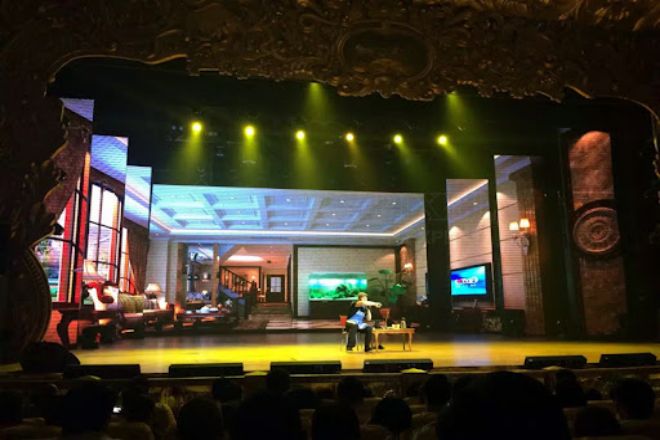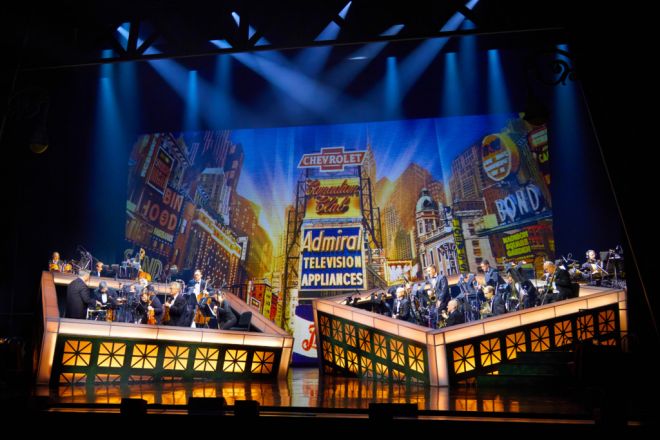介绍
1、影院LED显示屏创新应用背景
1). 技术创新驱动力
近年来,LED显示技术取得了长足的进步,成为推动影院视觉呈现革命的关键因素。
高清显示技术的不断突破,使LED屏幕能够呈现出色彩还原极高的细腻图像,给观众带来更加真实、生动的视觉体验。
与此同时,高亮度 功能保证即使在强光环境下屏幕内容依然清晰可见,满足复杂灯光条件下的影院需求。
广色域技术的应用,进一步拓宽了色彩表现范围,画面更加鲜艳饱满,增强了表演的感染力。
此外,LED显示屏灵活的拼接能力,可以根据影院的实际空间和需求,对屏幕进行定制,实现无缝拼接,为舞台设计提供了更多的可能性。
2). 市场需求变化
随着观众审美水平的提高和娱乐方式的多样化,对戏剧表演的期待已不再局限于传统的表演形式。
观众渴望更加身临其境的观演体验,希望与表演产生情感共鸣,甚至参与到表演过程中。
这种对沉浸式、互动式演出体验日益增长的需求,促使剧院不断探索新的技术手段来满足观众的需求,而LED显示屏凭借其独特的优势,是实现这一目标的理想选择。
LED显示屏通过动态变化的影像及实时互动功能,为观众营造出全方位、多感官的观演环境,让观众仿佛身临其境,与剧中人物同甘共苦。
3). 剧院改造升级需求
在数字化、网络化时代背景下,传统剧院面临着前所未有的挑战和机遇。
一方面,新兴的数字娱乐方式不断冲击传统影院的市场份额;另一方面,技术的进步也给影院带来了前所未有的发展机遇。
为了应对这些挑战、抓住机遇,影院需要不断转型升级,提升竞争力和吸引力。
LED显示屏作为现代科技与传统艺术结合的典范,已成为剧院创新转型的重要工具。剧院通过引入LED显示技术,可以打破传统舞台的限制,实现更加多元化、个性化的演出形式。
同时还可以利用数字化手段,提高观众的观影体验和服务品质,提升影院的品牌影响力和市场竞争力。
2、影院LED显示屏具体应用场景

1). 舞台背景及布景
LED显示屏在剧场舞台上的应用,大大丰富了背景和景物的表现力,作为动态舞台背景,LED显示屏可以实时显示高清绚丽的图像,实现瞬间的场景转换,无需复杂的物理景物变化。
这不仅节省了时间和人力成本,也增强了演出的故事性和视觉冲击力。
此外,通过虚拟现实(VR)和增强现实(AR)技术的结合,LED显示屏可以创造出超越现实的场景效果,让观众仿佛置身于一个新世界,享受前所未有的视觉盛宴。
2). 观众互动体验
为了增强观众的参与感和沉浸感,剧院开始在观众席周围或者上方安装LED显示屏。
这些显示器不仅用于实时显示演出信息,如节目单、演员介绍等,还可以用于互动观众投票、特效反馈等活动。
观众可通过手机或其他设备参与互动,观众的反馈将即时显示在LED屏幕上,形成强大的互动效果。
此外,LED显示屏还能实现观众与演员跨时空的互动,比如通过视频连线让演员与观众直接对话或根据观众的反应调整表演内容,大大增加了演出的趣味性和互动性。
3). 多功能厅及休息区
影剧院的多功能厅、休息区等也是LED显示屏的重要应用区域。
在非演出时间,LED显示屏可以播放预告片、宣传片、艺术 展览等内容吸引观众驻足观看,提高剧院非演出时间的利用率和吸引力。
同时,LED显示屏还可作为剧场导航和信息服务的工具,为观众提供便捷的路线指引、座位查询、演出日程安排等信息服务,提升整体观众体验。
4). 特效与光影艺术
LED显示屏、灯光、音响等系统的完美结合,为剧场演出营造出独特的光影效果。
通过编程控制,LED显示屏可以呈现出各种色彩、形状、图案的变化,与灯光、声音相呼应,营造出神秘、浪漫、激动等多种情感氛围。
此外,LED显示屏在表达抽象概念、营造情感氛围方面也有着独特的优势。
它能够以直观、富有创意的方式呈现演出的主题思想和情感内核,拓展戏剧表演的艺术边界,给观众带来视觉和精神上的双重震撼。
3、影院使用LED显示屏会带来哪些实质性的好处?
影院使用LED显示屏将带来诸多实质性的好处,这些好处不仅体现在观众的观影体验上,还涵盖影院的运营效率、艺术表现力、经济效益等。具体的好处有以下几点:
1).改善观看体验:
增强视觉冲击力:LED显示屏可以呈现高清、鲜艳的图像、视频,使舞台背景和景物更加生动逼真,增强观众的视觉享受。
增强沉浸感:通过动态变化的图像和光影效果,LED显示屏可以营造更加真实的场景氛围,让观众仿佛置身于剧情之中,提高沉浸感。
实时互动:在观众席周围或上方安装LED显示屏,可以实现观众与演员的实时互动,如投票、评论反馈等,让演出更加有趣、更具互动性。
2).提高艺术表现力:
快捷的场景变换:LED显示屏可实现瞬间的场景变换,无需复杂的物理布景变化,提高了演出的灵活性和连贯性。
创意表达:LED显示屏为艺术创作提供了更为广阔的空间,艺术家可以利用其独特的视觉效果来表达抽象的概念、情感氛围等,拓展了剧院的艺术边界。
光影艺术:LED显示屏与灯光、音响等系统结合,可产生独特的光影效果,为表演增添神秘感和艺术性。
3).提高运营效率:
信息显示:可利用LED显示屏播放演出信息、节目单、演员介绍等内容,方便观众了解演出细节。
广告收入:在非演出时间,LED显示屏可以用来播放广告、宣传片等内容,为剧院带来额外的广告收入。
导航服务:通过LED显示屏提供影院导航、座位查询等信息服务,提高观众的便利性。
4).经济效益:
吸引观众:LED显示屏的引入可以增强剧院的科技感和现代感,吸引更多观众观看演出。
提高票价:由于LED显示屏带来的视觉享受和沉浸感的提升,影院有理由提高票价,从而增加收入。
长期投资回报:虽然LED显示屏初期投资较大,但其长期 生活、低维护成本、高效率使其具有较高的投资回报率。
4. 剧院LED显示屏常见问题

1).影院环境复杂,空间有限,LED显示屏如何散热?
- 解决方案:
采用高效的散热技术,如热管散热、液冷散热等,提高散热效率。
同时优化显示屏结构设计,增加散热面积,保证热量能及时排出。
另外,应合理安排显示屏的使用时间和强度,避免长期超负荷运行。
2). LED显示屏具有高 能量消耗 和运营成本
- 解决方案:
使用节能LED显示屏,降低能源消耗。同时,加强设备管理和维护,延长设备使用寿命,减少更换频率。
此外,还可以通过提高演出票价、广告收入等方式增加影院收入,缓解运营成本压力。
3).LED显示屏与灯光、音响的配合挑战
- 解决方案:
加强技术培训与交流,提高技术人员的专业能力。同时与设备供应商建立紧密的合作关系,共同解决技术难题。
此外,采用标准化的技术规范和流程,确保设备的兼容性和稳定性。
结论
随着技术的不断进步和观众需求日益多样化,LED显示屏在剧院领域的应用前景将更加广阔。
它不仅是提升演出视觉效果、增强观众沉浸感的有力工具,更是推动戏剧行业创新发展的重要力量。
通过不断的探索与实践,我们相信LED显示屏一定会在剧院舞台上绽放更加绚丽的光芒,为观众带来更加多元、优质的文化艺术享受。
最后,如果你想了解有关LED显示屏的更多信息, 请与我们联系。

